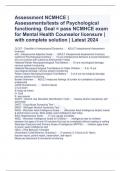Tentamen (uitwerkingen)
Midterm/ Final Exam: NR 509 / NR509 (Latest 2023/2024) Advanced Physical Assessment Quiz Bank | Questions and Verified Answers with Rationales | Chamberlain College
- Vak
- Instelling
Midterm/ Final Exam: NR 509 / NR509 (Latest 2023/2024) Advanced Physical Assessment Quiz Bank | Questions and Verified Answers with Rationales | Chamberlain College A patient has been diagnosed with venous stasis. Which of these findings would the nurse most likely observe? a. Unilateral co...
[Meer zien]





